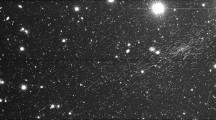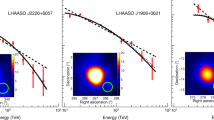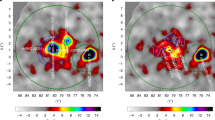Abstract
AMONG more than a thousand stereoscopic counter-controlled cloud chamber photographs of mesons which we have obtained during the past six months while studying the scattering of mesons of different energies in lead plates, we have obtained the photograph reproduced herewith. Each one of the stereoscopic cameras made an angle of 22½° with the normal to the chamber. The chamber was triggered by a triple coincidence Geiger – Müller counter system with 25 cm. of lead below the chamber and above the lowest counter, so at least one of the particles must penetrate 25 cm. of lead. There was no lead on the top of the chamber. The usual argon–alcohol mixture was used in the chamber.
This is a preview of subscription content, access via your institution
Access options
Subscribe to this journal
Receive 51 print issues and online access
$199.00 per year
only $3.90 per issue
Buy this article
- Purchase on Springer Link
- Instant access to full article PDF
Prices may be subject to local taxes which are calculated during checkout
Similar content being viewed by others
References
Bhabha, H. J., Proc. Ind. Acad. Sci., A, 11, 353 (1940).
Hughes, D. J., Phys. Rev., 69, 377 (1946).
Powell, W. M., Phys. Rev., 69, 399 (1946).
Author information
Authors and Affiliations
Rights and permissions
About this article
Cite this article
SAHIAR, A. A Doubly Charged Cosmic Ray Particle. Nature 161, 811–812 (1948). https://doi.org/10.1038/161811a0
Issue Date:
DOI: https://doi.org/10.1038/161811a0
Comments
By submitting a comment you agree to abide by our Terms and Community Guidelines. If you find something abusive or that does not comply with our terms or guidelines please flag it as inappropriate.



